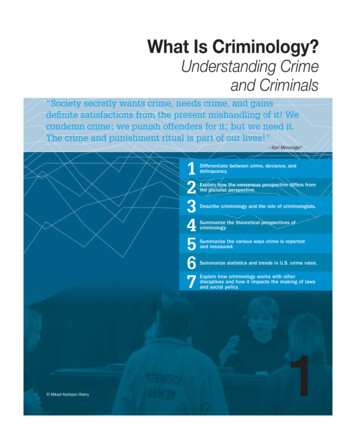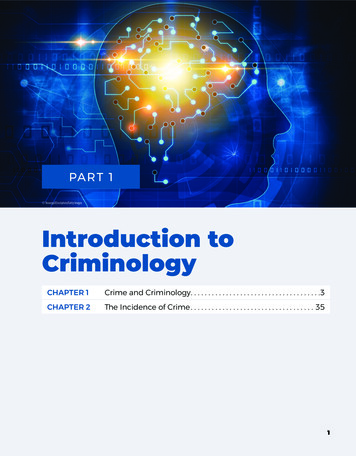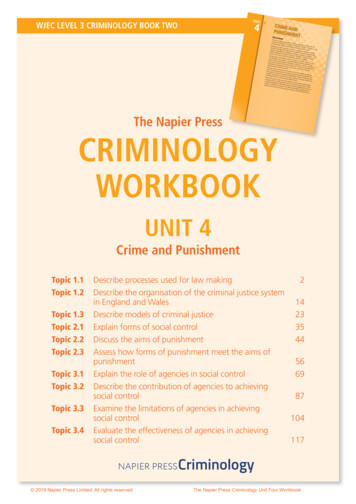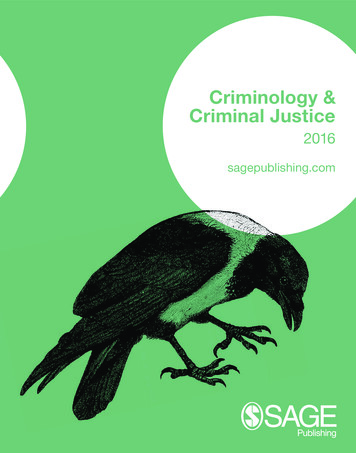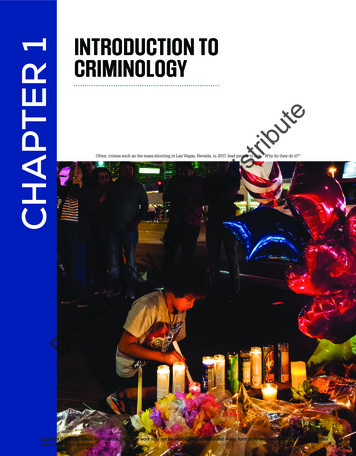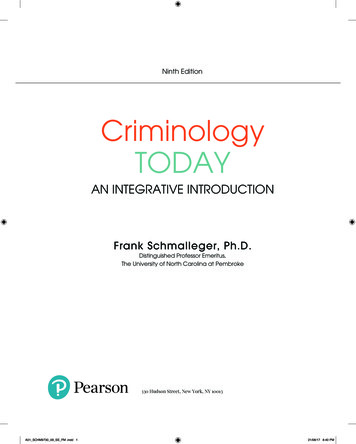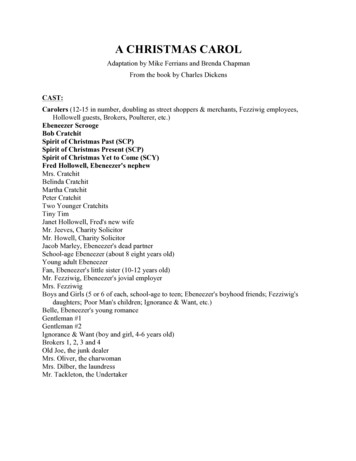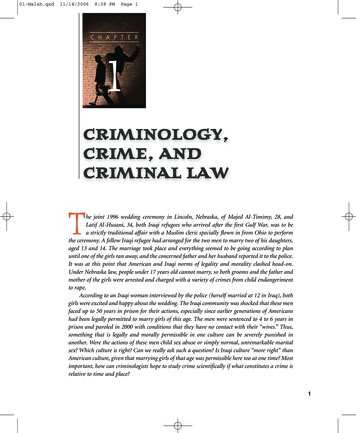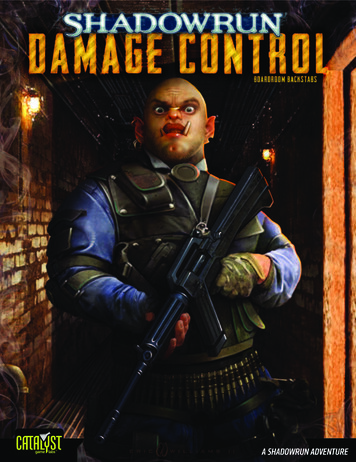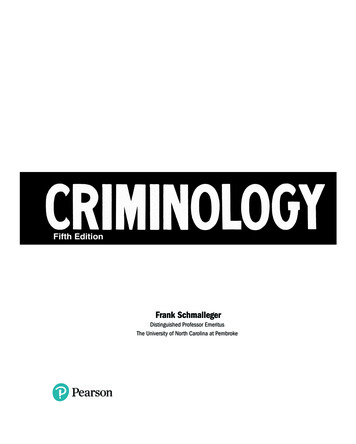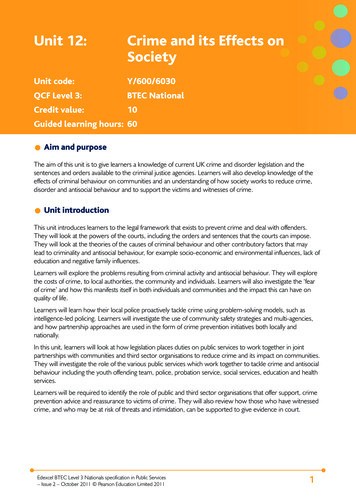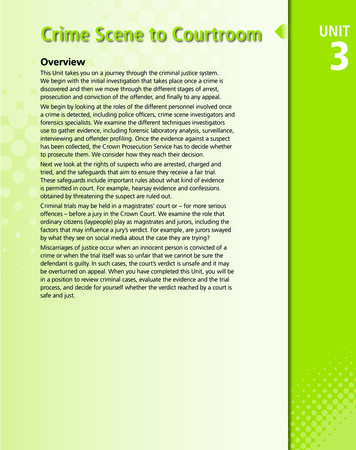
Transcription
Crime Scene to CourtroomOverviewThis Unit takes you on a journey through the criminal justice system.We begin with the initial investigation that takes place once a crime isdiscovered and then we move through the different stages of arrest,prosecution and conviction of the offender, and finally to any appeal.We begin by looking at the roles of the different personnel involved oncea crime is detected, including police officers, crime scene investigators andforensics specialists. We examine the different techniques investigatorsuse to gather evidence, including forensic laboratory analysis, surveillance,interviewing and offender profiling. Once the evidence against a suspecthas been collected, the Crown Prosecution Service has to decide whetherto prosecute them. We consider how they reach their decision.Next we look at the rights of suspects who are arrested, charged andtried, and the safeguards that aim to ensure they receive a fair trial.These safeguards include important rules about what kind of evidenceis permitted in court. For example, hearsay evidence and confessionsobtained by threatening the suspect are ruled out.Criminal trials may be held in a magistrates’ court or – for more seriousoffences – before a jury in the Crown Court. We examine the role thatordinary citizens (laypeople) play as magistrates and jurors, including thefactors that may influence a jury’s verdict. For example, are jurors swayedby what they see on social media about the case they are trying?Miscarriages of justice occur when an innocent person is convicted of acrime or when the trial itself was so unfair that we cannot be sure thedefendant is guilty. In such cases, the court’s verdict is unsafe and it maybe overturned on appeal. When you have completed this Unit, you will bein a position to review criminal cases, evaluate the evidence and the trialprocess, and decide for yourself whether the verdict reached by a court issafe and just.UNIT3
TOPICEvaluate the effectiveness ofthe roles of personnel involvedin criminal investigations1.1Getting StartedWorking in small groups, imagine you are a member of the public atthe scene of a suspicious death. What would you do and what doyou think the procedure would be to deal with this scene? You couldconsider the following:1. What is your first action?2. Who would you expect to arrive at the scene?3. What would the personnel who attend the scene be doing?The key personnel in criminal investigationsIn this Topic, we look at the key personnel involved in investigating crimes and the roles theyperform, and we examine the strengths and limitations of each of them.The following personnel are the ones most closely involved in criminal investigations: Police officers are usually first on the crime scene and they secure it for investigation.Police detectives lead the investigation into the crime. Crime scene investigators gather and preserve evidence from crime scenes for use ininvestigations. Forensic scientists examine, analyse and interpret crime scene evidence using their specialistknowledge and skills. Forensic pathologists specialise in establishing the causes of suspicious deaths.The Crown Prosecution Service makes the decision about whether to charge andprosecute a suspect.Police officersA police officer is usually the first person called to a crime scene and they have a vital role at thestart of the investigation. Officers need to safeguard the public and attend to anyone seriouslyinjured at the scene, for example by calling an emergency ambulance. If possible, they need toarrest the suspect, though in many cases they will have left the scene.However, as far as the investigation is concerned, the police officer’s key job is to securethe crime scene in order to conserve the evidence. As far as possible they should avoidcontaminating the scene by moving furniture, opening doors etc.ACTIVITYMediaPolice officers 8Go to www.criminology.uk.net
UNIT 3 CRIME SCENE TO COURTROOMInterviewsInterviewing witnesses to a crime or interviewing forensic and other experts can be an importantpart of an investigation and court case.Eye-witness testimonyEye-witness testimony (EWT) is the evidence given by a witness to a crime. Juries are often willingto accept EWT as an accurate account of an incident and they frequently give more weight toit than to other kinds of evidence. For example, the Devlin Committee in 1976 found that juriesconvicted in 74% of cases where line-up identification was the only prosecution evidence.However, their faith may be misplaced. For example, the Innocence Project in the USA has foundthat in over 70% of 352 wrongful convictions that were later overturned on the basis of DNAevidence, eye-witness misidentification played a role in convicting an innocent person – including15 cases where the person spent time on death row.ACTIVITYMediaEye-witness testimony Go to www.criminology.uk.netMemory problems of EWTMany of the problems with relying on EWT concern witnesses’ memories. There are threeaspects to memory: acquisition: witnessing the crime and absorbing what is happeningretention: storing the information in the memoryretrieval: recalling the memory, e.g. when being interviewed by police or identifyingsomeone in a line-up.18Protest against undercover police who infiltratedpeaceful protest movements over a 24-year period.
Typological profiling divides crime scenes and offenders into two types: organised and disorganised.The table uses the example of murder cases to show the difference between the two types.Type of murderLikely characteristics of the murdererOrganised crimeOrganised murderer The crime is planned, e.g. murderer takes weapon Above average intelligence (but possibly anand restraints to the crime scene Attempts to control the victim Leaves few clues at the crime scene (removesevidence) The victim is a targeted stranger.underachiever) Manipulative, cunning, outwardly normal,concealing sadistic personality Socially and sexually competentUNIT 3 CRIME SCENE TO COURTROOMBy carefully analysing the crime scene, it may be possible to identify the type of offender andtheir likely characteristics, such as their personality, lifestyle, relationships and motives. Theprofiler therefore gathers all the available information about the crime scene, the victim and theforensic evidence. Usually living with a partner Angry/depressed at time of the attack Follows media coverage of the attack.Disorganised crimeDisorganised murderer Spontaneous – little planning or preparation, e.g. Lives alone, near to the crime sceneweapon improvised at the crime scene Sexually and socially inadequate Random, disorganised behaviour Suffers severe forms of mental illness Minimum use of constraint Physically or sexually abused in childhood Little attempt to hide evidence at the crime scene, Frightened and confused at time of the attack.e.g. leaves murder weapon behind.The profile can then be used by police to identify likely suspects and narrow down their search.It can also be used to predict the likely future behaviour of the offender, such as whether andwhere they might strike next.Typological profiling was originally developed in the 1970s in the USA by the FBI. Since then,further typologies have been developed to classify rapists, based on their behaviour whenoffending. For example, the ‘power assertive’ type uses rape to assert his masculinity, while the‘power reassurance’ type is motivated by fear of sexual inadequacy. Other types include ‘angerretaliatory’ and ‘anger-excitement’ rapists.Evaluation of typological profilingThe investigative psychologist David Canter makes several criticisms of this approach: Information available at the crime scene may be quite limited and not collected understrict conditions. Speculations about the offender’s likely personality, relationships or motives are not muchhelp to police in finding them. The profile is based on the profiler’s subjective opinion about which evidence is important, sodifferent profilers might produce completely different profiles of the same case. The typology is based on interviews that the FBI conducted with just 36 convicted serial killersand rapists. This is a very small sample, and the offenders may be untypical of those who arenot caught, as well as being manipulative and dishonest.However, typological profiling has helped to solve some high-profile crimes in several countries.It can also help police to predict the likelihood of future crimes.21
UNIT 3 CRIME SCENE TO COURTROOM“Wherever the offender steps, whatever he touches, whatever he leaves, even unconsciously,will serve as a silent witness against him. Not only his fingerprints or his footprints, but his hair,the fibres from his clothes, the glass he breaks, the tool mark he leaves, the paint he scratches,the blood or semen he deposits or collects. It is factual evidence. Physical evidence cannot bewrong, it cannot be wholly absent. Only human failure to find it, study and understand it candiminish its value.”ACTIVITYMediaLocard’s principle Go to www.criminology.uk.netCollecting, transferring and storingphysical evidenceDifferent types of physical evidence need to be collected, transferred (e.g. to a forensics laboratory)and stored in order to preserve them and to prevent contamination. Most contamination occurs byhandling items without gloves or by breathing, sneezing or coughing over them.In the case of serious crimes (e.g. rape, murder or arson), investigators wear protective clothingwhen collecting materials, to avoid contamination and sometimes to protect themselves fromhazardous substances. This includes a mask, a hooded ‘scene suit’, overshoes and two pairs ofgloves. For less serious crimes, only a mask and gloves are required.Bodily fluids and tissuesBodily fluids such as blood, semen and saliva, and tissue such as skin flakes and hairs, canprovide important identification evidence, because DNA can be extracted from them andBelfast, 2013. A fully-suitedCSI gathers evidence afterpipe bombs were thrownat police.26
UNIT 3 CRIME SCENE TO COURTROOM there is ‘new and compelling evidence’ of an acquitted defendant’s guilt. This only applies to veryserious cases and may result in a re-trial, as in the case of the murderers of Stephen Lawrence.The Court of Appeal’s powersThe Court of Appeal cannot re-try a case, but if itfinds that the original verdict was unsafe, it canorder a re-trial, vary the conviction or decreasethe sentence. Any further appeal would be to theSupreme Court.Appeals to the Supreme CourtThis is the highest court in the legal system and itsdecisions are binding on all other courts. As withthe Court of Appeal, leave is required to appeal –there is no automatic right to appeal to the SupremeCourt. The Supreme Court normally only hears caseswhere a point of law of general public importance isat stake.The Supreme Court was created in 2009. Beforethen, its role was performed by the House of Lords,via the twelve Law Lords (the country’s most seniorjudges) who sat in the House and who now sit in theSupreme Court.The Supreme Court: the highest court inthe landCONTROLLED ASSESSMENT PREPARATIONWhat you have to doUsing your notes from Topic 2.2, describe the following trial processes: pre-trial plea bargaining bail roles courts appeals.You should have knowledge of each of the stages of the trial process, including the roles of thepersonnel involved.The assignment brief scenarioWhere relevant, you should make reference to the brief in your answer.How it will be marked3-4 marks: Describe in some detail the stages of the trial process, including the personnel involved.1-2 marks: A simple/basic description of trial processes and/or personnel involved. May only be a list.Timing In your controlled assessment you will have approximately 20 minutes to completethis section.46
UNIT 3 CRIME SCENE TO COURTROOMTrial by media: the tabloid pressIn law, the accused is innocent until provenguilty after a fair trial. In a fair trial, the jury ormagistrates must only consider the evidencepresented to them in court. It would be unfairif a juror’s verdict was prejudiced by mediareports they had seen about the case.real news. real entertainmentjofiles45p Arrest landlordspied on flat couple Friend in jail forpaedophile crimes cops now probe36-year-old murderCertain high-profile cases attract a greatdeal of media interest and sensationalisedreporting, often with extremely negativecoverage of the defendant’s character orprivate life, and this may make a fair trialimpossible.In effect, the media have already found theaccused guilty and their blanket coverageof the case before the trial will most likelyhave been seen by the jurors, potentiallyprejudicing them against the defendant.theFridayDecember 31, 2010By GREIG BOX TURNBULLTHE eccentric landlord arrestedyesterday on suspicion of JoYeates’ murder used to peerintrusively into his flats, twoex-tenants said yesterday.J QUIZZED Jo’s landlordChris JefferiesThe couple also claimed noseyChris Jefferies, 65, refused to letthem put up net curtains toprotect their privacy in thebuilding where Jo, 25, lived.The husband said: “He made mywife feel very uncomfortable.”It emerged yesterday ex-teacherJefferies bought the Bristol flat Jorented from an old colleague who isin jail for child abuse. Police maynow reopen the nearby unsolved1974 killing of Glenis Carruthers.‘jo suspect ispeeping tom’FULL STORY: PAGES 4&5J STRANGLED Jo Yeates, 25For example, Cheryl Thomas found that a fifthof jurors serving on high-profile cases saidthey had found it difficult to disregard pre-trialmedia coverage of the case. They were morelikely to recall the defendant being portrayedTabloid libelling of Jefferies could have prevented aas guilty than as innocent.fair trial if he had been charged.Case studyTrial by mediaThe character assassination of Christopher JefferiesA disturbing example of trial by media is the case of the retired teacher Christopher Jefferies,who was arrested and questioned by police for the murder of his tenant Joanna Yeates in 2010.The tabloid press ran highly prejudicial articles about Jefferies. For example, the Sun claimed hehad been ‘branded a creepy oddball by ex-pupils, a teaching colleague and neighbours’, hadinvited pupils to his home, was domineering and was believed to be gay. The paper went on todescribe him in these words:“WEIRD ‘Strange talk, strange walk’; POSH ‘Loved culture, poetry’;LEWD ‘Made sexual remarks’; CREEPY ‘Loner with blue rinse hair’.”Other papers joined in. The Daily Mirror claimed Jefferies was a Peeping Tom; the Daily Stardescribed him as a foul-tempered angry weirdo. Most of the quotes about him were fromunnamed sources. The papers published photos of him shabbily dressed and with unkempt hair(in fact the clothing had been given to him by police after they had taken all his own clothes forforensic analysis).However, subsequent police investigations revealed that in fact the killer was a neighbour,Vincent Tabak. The Sun and the Mirror were found guilty of contempt of court for publishingarticles that could have prejudiced a fair trial, since it would have been virtually impossible tofind a jury who had not been exposed to the tabloids’ character assassination. Jefferies receiveddamages for libel from the papers and has since become a campaigner for privacy.58
ACTIVITYMediaThe role of a juror Go to www.criminology.uk.netStrengths of the jury systemJury equityUNIT 3 CRIME SCENE TO COURTROOMExemption Those selected for jury service are legally required to attend court. However, it ispossible to be excused on medical and other grounds, such as a holiday you have already paid for.Unlike judges, jurors are not bound by what a law says or by precedents (verdicts reachedpreviously in similar cases). As ordinary members of the public, they are free to decide a casebased on what they feel is fair or morally right, regardless of the law or how the judge mightdirect them to apply it to a case. This is called jury equity.Case studyThe trial of Clive PontingA good example of jury equity is the acquittal of the senior civil servant Clive Ponting. During theFalklands War with Argentina in 1982, the British navy sank the Argentinian cruiser, the GeneralBelgrano, with the loss of 323 lives. Britain had declared an exclusion zone around the FalklandsIslands and said that any Argentinian ship inside it would be attacked. The Belgrano had beenoutside the exclusion zone when it was sunk and was only attacked after a top-level governmentdecision to change the British navy’s rules of engagement.Three years later Ponting leaked secret government documents about the sinking to an MP andwas subsequently charged with breaching the Official Secrets Act 1911. Ponting did not deny hisaction (he had admitted it even before he was arrested) but argued in his defence that he hadacted in the public interest by revealing the facts.The judge ruled that Ponting had no defence and directed the jury to convict him as he hadclearly contravened the Act by leaking official secrets. The jury nevertheless acquitted him.1 May 1982: the General Belgrano is sunk.Life rafts saved many but 323 died in whatsome critics described as a war crime.61
UNIT 3 CRIME SCENE TO COURTROOMEqually, the police’s lies, cover-ups, victim-blaming and falsifications of evidence mean that theiraccount of the events and their role in them lacks any validity.ACTIVITYMediaHillsborough Go to www.criminology.uk.netHillsborough, 15 April 1989. Some fans are rescued from the crush but 96 others died.The inquest on Mark DugganThe judgements in inquests into suspicious deaths have often been challenged. For example, thefamily of Mark Duggan, whose shooting by police sparked the 2011 riots, sought to overturnthe inquest verdict of lawful killing.Duggan was killed by a police firearms officer who believed, incorrectly, that Duggan was armedwith a handgun. At the inquest, the coroner directed the jury that if they accepted that theofficer honestly believed he was in danger and was acting in self-defence, they should return averdict of lawful killing. This was in fact their verdict.On appeal, Duggan’s family argued that the coroner had misdirected the jury. He should havetold them that they must also consider whether the officer’s belief was based on reasonablegrounds and if not, that they should return a verdict of unlawful killing.However, the Court of Appeal rejected the family’s appeal on the grounds that it was a matterof common sense that the jury would consider this, and that the coroner giving them detaileddirections could confuse them.The validity of the initial judgement and that of the Court of Appeal can be debated and thereremains disagreement about whether the jury understood that it was possible to bring in averdict of unlawful killing.ACTIVITY74MediaThe Mark Duggan case Go to www.criminology.uk.net
UNIT 3 CRIME SCENE TO COURTROOMVigil outside Tottenham police station after the inquest found Mark Duggan was lawfully killed.Law reportsLaw reports are reports of decisions made by courts. They are published on a regular basis – manyof them weekly. Their purpose is to inform lawyers and judges about important judgements in thecourts and to prevent two courts reaching differing decisions on identical facts.A report contains the following sections: the case header: the names of the parties involved, the date, the court and the judgethe key words relating to the case (e.g. hearsay evidence) and the key issues involvedthe headnote: a summary of the facts, the court’s decision and any case law consideredthe judgement: a transcript of the exact words used by the judge to explain his or her reasoning.The principle of precedentOnly about 2% of all cases are reported in law reports. These are the cases that set aprecedent – that is, they lay down a new principle of law.In England and Wales, the principle of precedent governs how courts reach many of theirdecisions. Precedent involves following the decisions that have been made in previous similarcases. Where the point of law in the present case and a previous one is the same, the courtshould follow the decision of the previous case.Following precedent promotes consistency and fairness between similar cases, and it alsoprovides certainty – people can know what to expect in a case, given the decision that wasreached in a similar previous case.Why are law reports important?The courts can only follow precedent if they actually know what the previous decision was and thereason for it. It is therefore vital to have details of the earlier case, and this is the role of law reports.A report provides a full and accurate record of all the relevant information. This means the courtcan rely on it as an authoritative statement of the legal principle on which the case was decided.This enables the court to see whether the earlier case sets a precedent for the one they arecurrently dealing with.75
Preparing for the Unit 3controlled assessmentWhen you have completed Unit 3, you will sit the controlled assessment.This section gives you some guidance on how to prepare for it.What does it involve?The controlled assessment involves a single task covering the eleven Unit 3 Assessment Criteria(ACs) and you must address them all in your answers. They are dealt with in the eleven Topicscovered in this book.Using the brief You will be given a brief, which is a scenario describing a criminal case. Think ofit as a prompt to remind you about some of the ACs that you need to deal with in your answers.You should make reference to the brief in your answers, but only where it is particularly relevantto do so.Prepare your file in advanceBefore you sit the assessment, it is essential that you have thoroughly prepared your notes for alleleven ACs, because you will need to take them with you into the assessment.On the next page is a checklist of what you need to do for each AC. Use this to make sure youhave written your notes on all of them so that you have everything covered before you sit theassessment. For help making notes on each AC, refer back to the Topic with the same number.On the day of the assessmentOn the day of the controlled assessment, make sure you bring all your Unit 3 materials and haveyour file in good order.You are allowed to have access to your class notes and to information sources, but you are notallowed to access the internet. You can’t take in any electronic documents or devices. Everythingyou need must be on paper, so if you have any electronic notes you must print them off if youwant to take them into the assessment.Use your headings!When completing your controlled assessment task, it’s a very good idea to use the eleven ACs asheadings and write about each one in turn, so that you make sure you have covered everythingand maximised your marks.TimingDivide up your time according to how much each AC is worth, as follows:84 For AC1.1, spend about 45 minutes.For AC1.2, spend about 100 minutes.
Describe models of criminal justiceGetting startedWorking in a small group, consider the following two views:TOPIC1.3A. To protect society, criminals should be caught and locked up as quicklyas possible. It’s worth risking a few innocent people going to prison ifthis helps us to catch most of the guilty ones.B. To protect the individual, it shouldn’t be easy to convict a person of acrime. It’s better to risk some guilty people going free than to send aninnocent person to prison.Discuss which view you agree with more. From your discussion, note downany problems you find with each view. Do you agree as a group?Two models of criminal justiceIn 1968 Herbert Packer, an American professor of law and criminology, described twocontrasting sets of values which shape the way criminal justice systems work. He sums these upin two opposed models of criminal justice: the crime control model of justicethe due process model of justice.The crime control model Crime is a threat to people’s freedom and so the goal of the crime control model is thesuppression of crime. It prioritises catching and punishing offenders, deterring and preventingthem from committing further crime. The model starts from a presumption of guilt. It trusts the police to be able to identify thosewho are probably guilty through their investigations and interrogations. Police should be free from unnecessary legal technicalities that prevent them investigating crime. It argues that if a few innocent people are occasionally convicted by mistake, this is a priceworth paying for convicting a large number of guilty people. It emphasises the rights of society and victims to be protected from crime, rather than therights of suspects.Once the ‘probably guilty’ are identified, it favours a conveyor belt or assembly line justicesystem that speedily prosecutes, convicts and punishes them.QuestionWhat sort of ‘legal technicalities’ might supporters of the crime control model want to remove sothat police can investigate more effectively?97
UNIT 4 CRIME AND PUNISHMENTCommunity sentencesCommunity sentences are imposed for offences which are too serious for a discharge or a finebut not so serious that a prison sentence is necessary. A Community Order given by the courtwill have one or more requirements, such as: supervision by a probation officerbetween 40 and 300 hours unpaid work (Community Payback)a curfew or exclusion ordera residency requirement, e.g. to live at a supervised, probation-approved hostela group programme, e.g. anger management, drink-drivers etc.treatment for drug or alcohol addiction (including testing), or for mental health problems.Do community sentences meet their punishment aims?Community sentences have several aims: punishment (retribution) by society for wrongdoing,reparation to individual victims and/or the community, and rehabilitation to prevent recidivism(re-offending).RetributionAll community sentences must include an element of punishment or retribution. For example,curfews and exclusion orders restrict offenders’ movements to certain times and places. Thisis a form of retribution, making the offender suffer limits on their freedom.Likewise, those doing unpaid work have to wear high visibility vests with ‘CommunityPayback’ on the back. The public ‘naming and shaming’ that this involves is also a formof retribution.118Unpaid work in the community: a way of making reparation?
an absolute (or unconditional) discharge means that no penalty is imposed. The courtmay grant an absolute discharge where the defendant is technically guilty but wherepunishment would be inappropriate, usually because the defendant is morally blameless. It isnot classed as a conviction.UNIT 4 CRIME AND PUNISHMENT Absolute discharges are normally only used for minor offences but in the Thirsk rail crash of1892 in which ten people died, a signalman was found guilty of manslaughter but given anabsolute discharge because of the very unusual circumstances of the case.ACTIVITYResearch and discussionThe Thirsk rail crash Go to www.criminology.uk.netDo discharges meet their punishment aims?The basic aim of discharges is deterrence. They are the lowest level of punishment and are in effecta warning as to the individual’s future conduct. In general, there is a low rate of re-offendingfollowing a discharge, especially if it was for a first offence – probably because for many firstoffenders, the experience of simply going to court is enough for them to mend their ways. In thisrespect, discharges appear to largely meet their punishment aim.PREPARING FOR THE EXAMQuestionsAssess how well community sentences meet the aims of punishment. (8 marks)AdviceFirst explain what community sentences are. Remember to include prisoners released on licence to servepart of their sentence in the community as well as those given Community Orders. Identify some of therequirements, e.g. Community Payback, addiction treatment, exclusion orders, residency requirements,attendance on courses. Link these to different punishment aims, e.g.: Community Payback and reparation, as well as retribution (e.g. wearing vests labelling them asoffenders is public ‘naming and shaming’ ) treatment for addiction or mental health problems and rehabilitationexclusion orders and public protectionattendance on vocational training and rehabilitation.Explain how or whether these requirements achieve the punishment aim. For example, there areproblems of non-attendance on courses, or lack of places on them. On the other hand, communitysentences have lower recidivism rates than imprisonment.If you do this as a timed question, you should spend no more than 10 minutes on it. Aim to write about150 words.121
UNIT 4 CRIME AND PUNISHMENTPrisonsPhilosophyHM Prisons and Probation Service (HMPPS) is the government agency responsible for the UK’sprisons. It describes its purpose as ‘preventing victims by changing the lives of offenders’.Aims and objectivesThe prison service has three main aims: to protect the public from harm to hold prisoners securely and implement the sentences and orders of the courts.to help people who have been convicted of offences to rehabilitate so they can contributepositively to societyFundingPrisons are paid for by the government out of general taxation. In 2018, the total budget forprisons was approximately 3 billion – 16% lower than in 2010. This has resulted in cuts tostaffing levels, with a 15% fall in the number of prison officers between 2010 and 2018. As aresult, many more experienced officers have left the service: by 2018, a third of prison officershad less than two years’ experience. According to HMPPS, the cost of keeping a prisoner inprison in 2017-18 was 37,543 per year.Working practicesIn 2019 there were a total of 122 prisons, holding over 82,000 prisoners. Of these, 108 werepublic sector prisons, run by the government, and 14 private prisons, run by three privatecompanies –Sodexo, G4S an
Police officers Go to www.criminology.uk.net ACTIVITY Media 8 TOPIC 1.1 Evaluate the effectiveness of the roles of personnel involved in criminal investigations Getting Started Working in small groups, imagine you are a member of the public at the s
